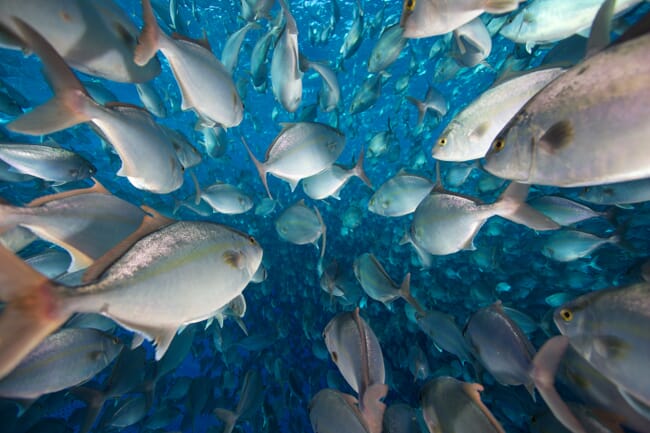
Hawaii is home to the most advanced offshore aquaculture operations in the US © Blue Ocean Mariculture
Titled What Will We Grow Here? An Analysis of Candidate Species for Open Ocean Aquaculture in the United States, the report explores how open ocean aquaculture can increase domestic seafood production while highlighting species most likely to thrive in offshore environments. It categorises species into finfish, shellfish and seaweed, providing a roadmap for the future of US aquaculture.
Key highlights from the report
- Finfish: Species such as cobia, kanpachi, Atlantic salmon and steelhead trout are identified as strong candidates for immediate cultivation. Future candidates with commercial potential include California yellowtail, red drum and Atlantic cod.
- Shellfish: Blue mussels are highlighted as the primary shellfish species with potential for open ocean farming.
- Seaweed: Giant kelp and bull kelp are featured as promising macroalgae species, drawing on case studies from Australia due to the lack of existing domestic seaweed farms.
Industry support
“I am really pleased to see this comprehensive review of the wide array of potential species that could be cultured in US offshore waters,” said Neil Sims, founder and CEO of Ocean Era.
“Much of the impediment to growth in this industry here is based on misinformation or a lack of information, and it is most helpful to have such a widely recognized, authoritative voice as EDF, providing an objective assessment of the pros and cons of the plethora of possible fish, shellfish, and seaweeds that might be cultured in offshore US waters. It is very timely,” h added.
The report stresses that species selection is crucial to the success and sustainability of offshore aquaculture. Without careful management, however, this emerging industry could pose environmental risks.
"Open ocean aquaculture has great potential to strengthen US seafood supply and reduce reliance on imports, but it must be done in an environmentally responsible way,” said Poppy Brittingham, lead author of the report.
“This report offers a science-based framework for identifying species that can help meet these goals, while also acknowledging the need for careful consideration of ecological impacts.”
The report evaluates economic feasibility and environmental impacts using domestic and global case studies. Notably, it stresses the value of pursuing integrated multi-trophic aquaculture (IMTA), where species, such as seaweed and shellfish, are co-cultivated with finfish to reduce waste and improve sustainability.
The importance of planning
As the US aquaculture sector is still in its early stages, the report emphasises strategic planning to mitigate risks such as nutrient pollution, disease transmission, and the potential spread of invasive species from fish escapes. It also highlights the need for ongoing research and investment to address knowledge gaps in offshore aquaculture, including farm siting and operations.
“EDF’s report is a timely reminder of the many marine species that we could potentially farm in our offshore waters,” said Matt Thompson, aquaculture programs manager, BalanceBlue Lab, Anderson Cabot Center for Ocean Life at the New England Aquarium.
“Depending on location, some species may have benefits in terms of market, biology, and even social licence (ie having fewer conflicts, such as with commercial fisheries). The report also underscores that for several of these species there is a need for additional time, research, and technology to address biological, environmental, and engineering challenges to farming them, which could be an important consideration for many stakeholders, including industry leaders and policymakers.”
Factsheets on each potential species are available.




